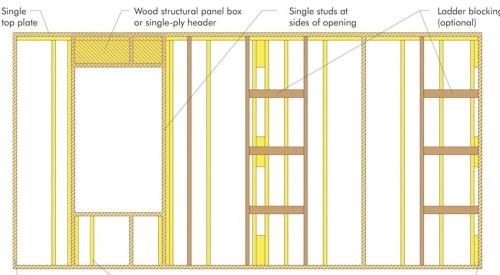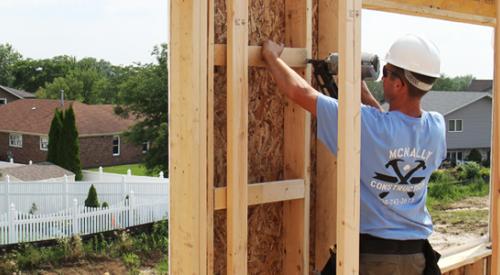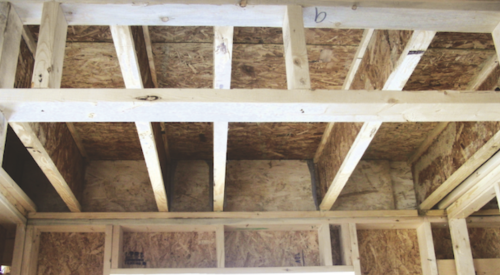www.pathnet.org
|
www.pathnet.org
|
The following innovations generally are included in the family of advanced framing techniques:
19.2- and 24-inch On-Center (OC) Framing: Widen wall and floor framing spacing to 19.2 inches or, more commonly, 24 inches instead of the normal 16 inches. Combine this strategy with modular layout and/or a single top plate when appropriate for added economy. Maximize savings by coordinating the spacing and size of window and door openings. This can save substantial amounts of lumber in the floor and wall framing, although thicker decking and cladding might partially reduce the total savings.
Modular Layout: Build to a 24-inch module as much as possible using 24-inch OC wall and floor framing to minimize sheet and framing material cutting and waste while maximizing savings on materials and labor. Again, window and door placement and sizes should be coordinated carefully to maximize savings.
Single Top Plate on Exterior Bearing Walls: Use with modular layout, and usually with 24-inch OC framing, to stack the wall, second-floor and roof framing; it allows the use of a single top plate. Substantial savings in time and material are reduced somewhat by the need to brace recently erected walls to steady and plumb the walls. Often not appropriate in high wind areas and seismic zones.
Single Top Plate on Interior Nonbearing Partitions: More than one top plate is not needed on a nonbearing partition. However, a single plate can be confusing to the framer if used with a normal double plate on bearing and exterior walls because two lengths of stud are needed. Bracing is needed to steady and plumb recently erected walls.
Right-Sized Headers: Size each header for its particular load and span instead of sizing all headers in bearing walls to accommodate the worst case. This technique requires careful analysis and that the framer pays close attention to the plans.
No Headers in Nonbearing Partitions: Headers are unnecessary in nonbearing partitions, but framers cannot always tell which partitions are nonbearing. Again, the framer must pay attention to the plans to realize material and labor savings.
Ladders at T-Intersections: Use flat horizontal blocking between studs to secure a partition framing into another wall. This saves a lot of lumber but offers no savings of framing labor. Scrap pieces can be used to save a full stud at each intersection. Insulation can continue in the exterior wall behind the blocking, and uninsulated cavities are avoided.
Open Corner Framing: Only two studs are needed at an outside building corner, one at the end of each wall framing in. Additional framing is needed only to support the gypsum board at the corner. This can be done with a flat stud, leaving an open-ended corner, or with drywall clips, eliminating one stud. This alternative allows the open cavity at the corner to be insulated along with the wall, and the framer does not have to insulate a closed cavity before the sheathing is installed. In high wind areas and seismic zones, open corner framing might not be appropriate.
| Source: U.S. Department of Energy |










